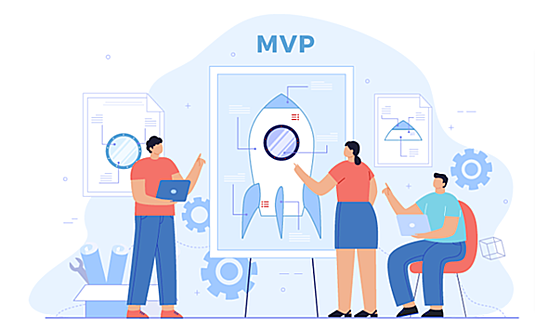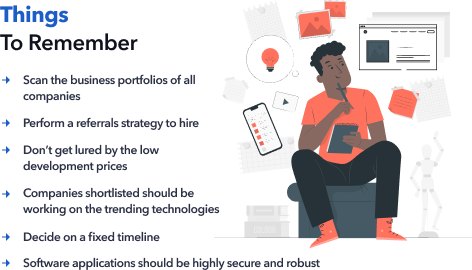Today, software development is not about building a software product that satisfies your targeted customer requirements. Instead, it’s all about creating a top-quality, innovative, reliable, secure, customized, and pocket-friendly software product that meets your customer needs.
Talking about a software development process, specifically custom software development, the process is highly organized, secure and customer-specific.
The software customization process helps enterprises understand customer pain points and unlock customer needs and future demands.
But before moving further with the development process, let’s first understand and identify the buyer personas.
Understanding The Targeted Audience
When designing or developing customized software, the first and foremost thing is determining your target audience. Or you can say who the people you are targeting your product to are? Do they need that? Or how you are going to engage them with your offerings?
Not only these, but many more questions might also pop up in your mind.
It’s all about diagnosing or identifying your buyer personas.
Before initiating custom business software development, you must be very clear with the questions and answer that.
-
What are problems am I solving?
-
For whom am I solving the problems?
-
Where will I find them?
-
What category do they belong to?
-
How do I engage them?
So, first, understand what the target audience means.
Target audience refers to a specific set of customers who are most likely to buy your product or service and have seen your ad campaigns on different platforms. You can segregate the target audience by age, gender, income, location, interest, etc.
More importantly, you can segregate your targeted audience into categories such as:
Audience with purchase intention: These are the set of audiences looking for a specific product and want to collect more information about that. The data here will make you see how you can better direct your message to your audience.
Audience with particular interest: These are people interested in some kind of hobby. The data collected helps you connect with your audience in a relatable way.
Audience with shared experience (subculture): People identify with a shared experience. These people define themselves by subcultures. And with that, companies can use those cultures to understand who they’re reaching out to.
They are also termed as buyer personas of a business.
How To Determine Your Target Audience?
Determining your target audience is a time taking process. You have to spend a lot of time analyzing the data you receive from customer engagements, evaluating current buyers, market trends, etc.
1. Identify Your Current Customers And Conduct Interviews
The first thing you need to start with is determining the targeted customers who have already purchased your product or have taken your service. Collect the data on how old they had made the purchase, their location, and their preferences. You can conduct their interviews one-to-one or ask them to fill out the online survey. You can better understand why your customers engage with your brand. You can conduct surveys on feedback platforms like Zonka Feedback, Google Forms, and SurveyMonkey.
2. Conduct Market Research And Identify Industry Trends
Conducting market research can help you identify your targeted audience and understand customer behavior and patterns.
It provides you with a broad overview of the people who consume your product.
Moreover, you can also hire a market research firm to study your specific audience. They can quickly sell or share your research reports. Gartner provides yearly marketing predictions to help you understand what marketing trends customers respond to.
3. Keep An Eye On Your Competitors
For more targeted customer analysis, you can check your competitors' strategies, marketing, promotion, and the customer segment they are targeting for their product offerings. Are they using online or offline channels? It can be a smarter move to spy on your competitor's doing to stay ahead of them.
4. Create Personas
Creating personas is a great way to retrieve specific target audience segments. It might be helpful to you as you have a broad range of customers. You can determine your target customers' demographics, personalities, and needs with personas. Buyer personas are created based on data, surveys, digital engagements, and other information marketers use to provide a complete overview of buyers.
5. Define Who Your Target Audience Isn't
There might be a group of customers close to your target demographic but will not act during customer interaction or messaging. Make sure you will be specific in determining who your audience is and who is not. Do not unnecessarily invest your time and money in choosing the incorrect audiences for your offerings.
6. Make The Best Use Of Google Analytics
Google Analytics stores comprehensive demographic data on your website visitors related to their location, interests, gender, and age. It can offer you extensive data about the visitors visiting your website. The information derived can be leveraged to determine critical insights, such as what channels your target audience is coming from or what type of content they’re engaging and like the most. It helps you to make more data-driven decisions.
Step-By-Step Development Process
Be it mobile app development, website creation, or software building, developing each is a complex process. On the contrary, any wrong decision taken in any stage of software development will affect the software quality and your entire business. Custom software development involves immense hard work, dedication, and rich expertise.
It’s crucial to conduct an in-depth market analysis and customer demands as it ultimately adds value to your business. So, let’s get started with a detailed analysis of every stage of the custom development process.
Step1: Ideation
Coming up with innovative ideas is quite challenging as new technological innovations are emerging at a rapid pace. It leads to product managers thinking globally to create an innovative software product that offers something unique is considered an effective technique in the IT environment. All team members should contribute their ideas during meetings and discussions. Planning the product idea creates the prime requirements of the project and a roadmap that influences the whole development process.
Step 2: Software Design
After planning, the next phase is to design the product's technical architecture. In this phase, the team provides the business specification to technical teams, building the product’s architecture and creating workflow diagrams, tech stack, and DB design. It is simply conceptualizing the product. Here you start sprint planning or break down large tasks into more actionable modules.
In the end, designers are responsible for building the whole project structure.
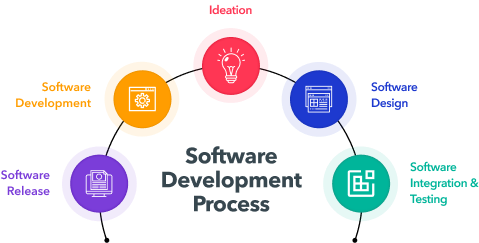
Step 3: Software Development
This phase is the most crucial stage of the software development process. In this phase, developers started coding according to SRS's business requirements.
With every team member on board with the software’s proposed functionality and design, it’s time to develop the software. Whether you follow the Agile approach or MVP prototype, the main aim is to follow all the software requirements described in SOW to build robust, scalable, and efficient software.
After completing the development phase, an MVP product is the first release that few early adopters may mostly use.

Step 4: Software Integration and Testing
To check whether a software program is working efficiently, you must perform software testing to avoid bugs and product failure. Testers perform in-depth testing to track and fix bugs. Here we simply release the product to a small group of beta testers or use UX tools to track how users interact with it.
During this phase, QA engineers test the code’s quality by using different frameworks and testing methods to check any bugs in the system. Testers report test cases and inform the developers of the bugs to developers to fix them. It helps them build a bug-less software product.
Step 5: Software Release
Once done with the software product, it’s time to launch your software in the market and let your audience access it. Your development team should now be confident about the functionality, usability, and stability of the product developed. After receiving feedback in the Alpha release, the team now moves towards the Beta release phase. The final product here gets the feedback from customers and makes necessary changes following that.
Last but not least, the next phase is continuous monitoring of the product, its usage, and future growth. The bugs are then fixed based on the customer responses.

Top Tips To Accelerate Custom Software Development Process
We now understand that custom solutions help businesses to improve their customer interactions, optimize internal business processes with faster automation and streamline their collaboration with partners.
But how?
One of the most crucial points here is: change. To equip oneself with a scalable solution that could fit the changing customer needs. Improving customer satisfaction and retention, efficient operations, and increased ROI is the #1 priority for every business today, as it should be.
And that is one of the significant factors for a brand to stay ahead and competitive in this rapidly changing digital business environment.
This section will discuss how custom software helps you accelerate the development process while satisfying customer requirements with favorable cost and time.
1. Customizing agile development is one way out.
Developing a digital product in an agile environment is about accelerating the development speed, reducing complexities, and customizing processes at each project stage. It helps you develop the fastest prototype that leads to further custom development. With agile software development, you can deliver your projects on time.
The process relies more on customer involvement and ensures speedy delivery of projects. As your project management breaks into smaller pieces, you can check each project step as it progresses. It provides greater flexibility as well as scalability.
2. Expanding team size for faster development
Another thing you can do to accelerate your custom software development process is team expansion. Think about enlarging your team. The more team members you onboard into your team, and the less work will be assigned to each member. This will lead them to focus on their specific tasks and complete them on time.
Sharing the responsibility and delegation among team members accelerates the software development process. Effective and seamless internal communication between team members is vital to the success of every project. The more team members you hire with different expertise combined, helps you achieve your business goals.
.png?width=440&name=Chanllenges%20for%20CTOs%20-%20IMG%20(7).png)
3. Identify your actual Key Performance Indicators (KPIs)
Now that you have to speed up your software development process, you might determine how you will measure the speed improvement. Make sure you focus on actual measurements, including the number of tasks completed, to stay on track with the delivery date.
Always keep an eye on the number of tasks completed each day instead of looking at the number of lines of code written. Businesses always look forward to developing software faster and at a favorable cost. And you can’t waste it on rework, refactoring, physical meetings, etc. Your product will be a big hit if you all this thoroughly.
4. Software Development Outsourcing is the best option
Another widely used and popular technique to accelerate your software development process is none other than outsourcing software development.
Software outsourcing is all about delegating your business operations to an outsourcing firm that adds expertise to your business. You can simply outsource a specific software feature or the complete software development whatever you want, which entirely depends on your business requirements.

Today, outsourcing has been beneficial to businesses of all scales and industries. It is the strategic move adopted by CTOs, product managers, entrepreneurs, and others to boost their business goals. With outsourcing, you not just have a significant amount of funds, but you can have access to significant expertise in IT operations and, of course, faster development. Outsourcing can help you solve all your business challenges and save money if done right.
5. Implementing Cloud Technologies speeds up your app migration
Almost every organization wants to run its business applications with higher performance and lower costs. Isn’t it? With the assistance of cloud technologies, you can make your app migration smooth and seamless.
Today, most businesses use cloud platforms and technologies to move their existing custom applications to the cloud and are interested in building cloud-native applications.
Cloud technologies undoubtedly make the work of application developers more efficient.
Remember These Proven Software Development Practices
To ensure that your software product provides greater profits and immense business growth, you must choose custom software development. Not only choosing, but you also need to follow certain practices efficiently to manage business processes and a smooth workflow.
1. Defining Business Requirements And Goals.
Before building any software, app, or website, it’s crucial to define your business requirements, current process status, expectations, and metrics to measure success. Here we describe the overall project management process in three simple questions that you need to answer.
Make sure you have the answer to the given questions:
- What is your current process and its status? Avoid making assumptions; get clear answers straightway from experts.
- Why do you need to upgrade or modify your existing system?
- What are your desired workflows and other processes to support the software?
2. Hire The Right Team Of Professionals.
You can’t handle everything independently by making your in-house team work day and night to save money. For a smooth performance of custom software development, you need the following professionals to manage business processes and workflows efficiently. They are:
Outsourcing your process or an entire project to a software outsourcing company helps you get efficient and reliable software with the assistance of expert professionals in the end. These professional teams have successfully designed and implemented multiple custom software.
3. Prepare A Realistic Plan With Milestones.
A realistic plan with achievable milestones is necessary to keep in mind to get a desirable product. You need to set up a skilled team of professionals that leads and directs you towards the overall objective. Creating a detailed roadmap is also vital for your business.
Make a clear plan to achieve milestones at each stage and keep the project on track. Review and get responses from immediate users at each stage to know whether you reach your set milestones or not. Also, planned the timeline or budget accordingly.
4. Perform All Kinds Of Testing.
Testing is a crucial aspect that needs to be considered at the early stages of development to avoid bugs or failures. All kinds of testing (unit test, manual test, automated test, and so on) have to be performed by the testers thoroughly to keep track of every bug evolved and resolved. Test the software simply as expected.

5. Frame The Entire Software Process Efficiently.
Well, detailed and precise documentation for all stages of the software development and implementation is necessary for the smooth functioning of the software. Mention in the document what you have and what you desire.
Here is a quick checklist you need to prepare.
- A test plan
- A statement of scope
- An implementation plan
- A training plan and detailed user documentation
Custom software development helps you get used to the latest technology trends to solve specific crucial problems for your business. You should know how well you utilized it and when to support future growth and success.
Why Is Integration Important In Custom Software Development?
The Global System Integration Market is expected to rise from $320.44 billion to $601.95 billion by 2026.
According to 451 Research, 90% of companies are on the cloud, meaning cloud infrastructure services account for the highest growth.
These statistics demonstrate the value that software integrations offer to modern businesses. It’s safe to say that business needs continue to evolve shortly (and even now).
Because customers demand immediate service, businesses must meet that demand typically in real-time.
Software and system integrations open seamless communication between software applications, creating more opportunities for enhanced efficiency, customer experiences, and cost-efficiency.
1. Software Integration Leads To Error Reduction
Software automation creates a healthy and friendly software ecosystem where you can simply automate your workflows. It helps you eliminate manual, repetitive tasks and reduce human error.
With software integration, errors are minimized due to data synchronization. It helps you gather your scattered data that requires manual movement. Data movement is automatic in an integrated system, which minimizes errors. With faster automation and integration, employees can now focus on other projects.
2. Modernizing Legacy Systems With New-Age Software Products
Modernizing legacy systems involves integrating modern software features and functionalities with existing business systems. Companies often looking for legacy application modernization either transform their current systems or integrate them with modern applications. Still, businesses can enjoy leveraging software integration tools that ensure smooth, secure, and seamless data migration.
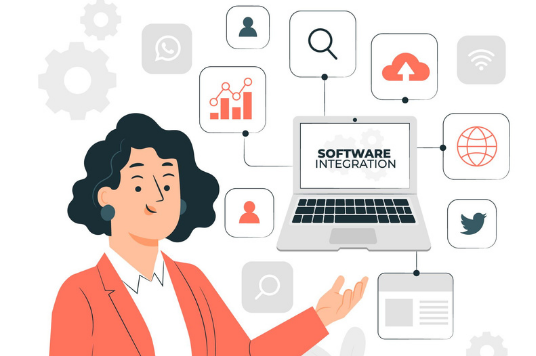
3. Custom Software Integration Supports Interoperability, Flexibility, Scalability, and improved security
Custom software integration facilitates businesses with increased interoperability, flexibility, and scalability. It helps entire information systems, devices, and applications collaborate with other business systems without any intervention.
Moreover, software integration also upgrades your security. With this, employees can only access data from an integrated system. This means better efficiency, improved data flow, seamless communication, etc. No more data breaches will be there.
4. Easy Accessibility Of Data And Improved Data Flow
With custom software integration, you can simply build a single system. This means the data will be in one place and ensures data accessibility. You can now access data anytime without any assistance. Also, with improved accessibility, you can save costs and time.
Integrated systems facilitate data automation which means better and smooth data flow.
Custom Software Development Trends That Are Popular In 2022
The ever-evolving technologies will bring down a significant change in the software development landscape. Businesses need to keep up with these changes to stay ahead in this next-gen world. They expect to see remote operation, complete automation, faster deployment, optimized business processes, etc.
So, we have come up with disruptive technologies that will take center stage in custom software development trends next year without further delay.
1. Composable Applications
The two modern ways of custom development are already mainstream and used by most businesses, i.e., IaC and low-code development.
Here we are talking about the composable application, which is the idea that functional blocks of an application can be dissociated from the complete application or process.
These applications permit any business module to be decoupled and enhanced separately without intervening in the rest of the application. They are more competent that can be created with better functionality and greater purpose.
You can find agile and composable applications faster to build and easier to innovate.
2. Low-code & No-code Development
How have modern code development practices changed the way of doing software development? The rising cutting-edge technologies lower the burden of coders to make code development faster and easier.
You can simply do this with low code or no-code development. With this, you can create software applications with minimal coding. Low code development environments employ graphical interfaces and tools to develop applications quickly.
Low code is the type of development that enables non-coders to create software solutions independently. It lets a team of developers focus on critical development tasks.
These development options have gained momentum in the current years. According to a study, the global market will need 500 million apps built within half a decade. Another study has estimated, however, that 65% of future apps will be made with low-code tools by 2024.
You must have heard about Canva offering drag and drop functionalities to its customers. This is an example of one of the websites offering no-code development services.
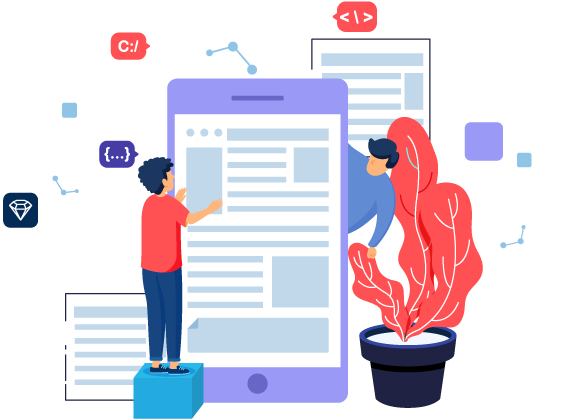
3. Cloud Solutions
Cloud computing was always and will remain in the technology mainstream in custom software development. Due to its high mobility, resiliency, and reasonable maintenance costs, cloud technology is used mainly by modern businesses.
Cloud-native apps always run on cloud computing architectures. It allocates resources to each service that an application uses, making it flexible and optimal to work in cloud environments.
According to a market forecast by Gartner, the aggregated end-user spending on public cloud services would hit $482.2 billion by 2022—up by nearly 22% from $396 billion this year.
Today, many companies will focus on cloud-native applications for uninterrupted business operations. Around 63% of high-growth companies have relied on a hybrid on-site and remote work arrangement to maintain organizational flexibility and profitability.
4. Software Integration
Earlier, an independent program was believed enough for a business to meet its commercial needs. But the technology landscape has entirely changed now. Modern technology has pushed the consumer's demands and preferences to the forefront.
The custom software applications have now supported external functionalities to provide a seamless and smooth user experience. The custom development has also encouraged in-house development teams to build applications with the existing frameworks and codebases. For example, Amazon integrates email and social media APIs across its e-Commerce platforms to enhance product visibility.
According to a recent study, 83% of companies deem API integration to be critical in their business strategy—with respondents citing enhanced productivity (59%), better innovation (51%), and revenue increase (43%) as the top benefits.
5. Internet of Things(IoT)
IoT infrastructure plays a vital role in software development, with around $639 billion projected market valuation by 2022.
IoT is all about having a seamless connection between intelligent home applications to create a seamless living experience for the customers in their daily lives.
IoT has empowered tonnes of industries to gather, deploy and analyze enormous data flowing through interconnected devices across diverse applications.
The large-scale business automation made it possible for companies to generate new revenue streams. The IoT development denotes the growing complexities of building applications beyond traditional physical devices.
 Healthcare 360 HealthTech
Healthcare 360 HealthTech Digital Economy New tech solutions
Digital Economy New tech solutions SaaS Development Modern SaaS solutions
SaaS Development Modern SaaS solutions Government Software E-Governance solutions
Government Software E-Governance solutions FinTech Automate financial system
FinTech Automate financial system Logistics Efficient operations
Logistics Efficient operations Retail E-stores Powerful online stores
Retail E-stores Powerful online stores Travel Simplified portals
Travel Simplified portals












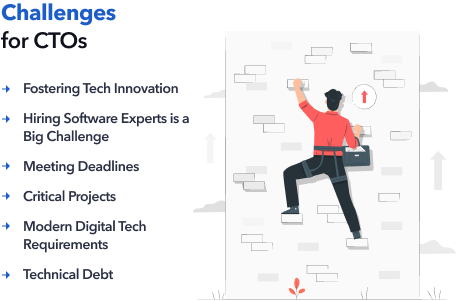
.png?width=416&name=Chanllenges%20for%20CTOs%20-%20IMG%20(2).png)
.png?width=416&name=Chanllenges%20for%20CTOs%20-%20IMG%20(1).png)
.png?width=446&name=Chanllenges%20for%20CTOs%20-%20IMG%20(6).png)



.png?width=440&name=Chanllenges%20for%20CTOs%20-%20IMG%20(7).png)




